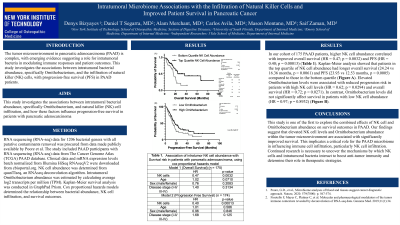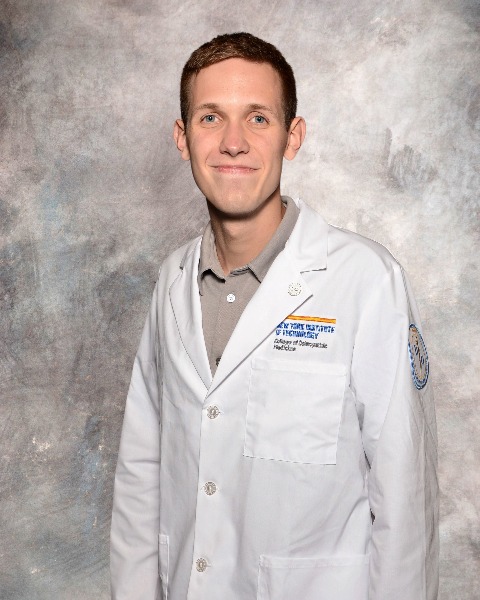Monday Poster Session
Category: Biliary/Pancreas
P1729 - Intratumoral Microbiome Associations With the Infiltration of Natural Killer Cells and Improved Patient Survival in Pancreatic Cancer
Monday, October 28, 2024
10:30 AM - 4:00 PM ET
Location: Exhibit Hall E

Has Audio

Denys Bizyayev, BS
New York Institute of Technology College of Osteopathic Medicine
Stamford, CT
Presenting Author(s)
Award: Presidential Poster Award
Denys Bizyayev, BS1, Alam Merchant, MD2, Daniel Segarra, MD3, Mason Montano, MD4, Alexander Shahin, MD5, Pavan Challa, MD6, Carlos Avila, MD7, Mohammed Al-Zakwani, MD, MS7, Saif Zaman, MD4
1New York Institute of Technology College of Osteopathic Medicine, Stamford, CT; 2Emory University School of Medicine, Atlanta, GA; 3University of South Florida Morsani College of Medicine, Tampa, FL; 4Yale University School of Medicine, New Haven, CT; 5Tampa General Hospital / University of South Florida, Tampa, FL; 6Yale New Haven Health, New Haven, CT; 7Yale New Haven Hospital, New Haven, CT
Introduction: The tumor microenvironment in pancreatic adenocarcinoma (PAAD) is complex, with emerging evidence suggesting a role for intratumoral bacteria in modulating immune responses and patient outcomes. This study investigates the associations between intratumoral bacterial abundance, specifically Ornithobacterium, and the infiltration of natural killer (NK) cells, with progression-free survival (PFS) in PAAD patients.
Methods: The study included PAAD participants with RNA sequencing (RNA-seq) data from The Cancer Genome Atlas (TCGA) PAAD database. Clinical data and mRNA expression levels batch normalized from Illumina HiSeq RNAseqV2 were downloaded from cbioportal.org. NK cell abundance was determined from quanTIseq, an RNAseq deconvolution algorithm. Intratumoral Ornithobacterium abundance was estimated by calculating average log2 transcripts per million (TPM). Kaplan-Meier survival analysis was conducted in GraphPad Prism. Cox proportional hazards models determined the relationship between bacterial abundance, NK cell infiltration, and survival outcomes.
Results: In our cohort of 175 PAAD patients, higher NK cell abundance correlated with improved overall survival (HR = 0.47; p = 0.0032) and PFS (HR = 0.40; p = 0.00013). Kaplan-Meier analysis showed that patients in the top quartile of NK cell abundance had longer overall survival (24.24 vs 16.36 months, p = 0.0061) and PFS (23.93 vs 12.53 months, p = 0.0005) compared to those in the bottom quartile. Elevated Ornithobacterium levels were associated with reduced progression risk in patients with high NK cell levels (HR = 0.62; p = 0.0294) and overall survival (HR = 0.72; p = 0.0271). In contrast, Ornithobacterium levels did not significantly affect survival in patients with low NK cell abundance (HR = 0.97; p = 0.8932).
Discussion: This study is one of the first to explore the combined effects of NK cell and Ornithobacterium abundance on survival outcomes in PAAD. Our findings suggest that elevated NK cell levels and Ornithobacterium abundance within the tumor microenvironment are associated with significantly improved survival. This implicates a critical role for the PAAD microbiome in influencing immune cell infiltration, particularly NK cell infiltration. Continued research is necessary to uncover the mechanisms by which NK cells and intratumoral bacteria interact to boost anti-tumor immunity and determine their role in therapeutic strategies.
Disclosures:
Denys Bizyayev, BS1, Alam Merchant, MD2, Daniel Segarra, MD3, Mason Montano, MD4, Alexander Shahin, MD5, Pavan Challa, MD6, Carlos Avila, MD7, Mohammed Al-Zakwani, MD, MS7, Saif Zaman, MD4. P1729 - Intratumoral Microbiome Associations With the Infiltration of Natural Killer Cells and Improved Patient Survival in Pancreatic Cancer, ACG 2024 Annual Scientific Meeting Abstracts. Philadelphia, PA: American College of Gastroenterology.
Denys Bizyayev, BS1, Alam Merchant, MD2, Daniel Segarra, MD3, Mason Montano, MD4, Alexander Shahin, MD5, Pavan Challa, MD6, Carlos Avila, MD7, Mohammed Al-Zakwani, MD, MS7, Saif Zaman, MD4
1New York Institute of Technology College of Osteopathic Medicine, Stamford, CT; 2Emory University School of Medicine, Atlanta, GA; 3University of South Florida Morsani College of Medicine, Tampa, FL; 4Yale University School of Medicine, New Haven, CT; 5Tampa General Hospital / University of South Florida, Tampa, FL; 6Yale New Haven Health, New Haven, CT; 7Yale New Haven Hospital, New Haven, CT
Introduction: The tumor microenvironment in pancreatic adenocarcinoma (PAAD) is complex, with emerging evidence suggesting a role for intratumoral bacteria in modulating immune responses and patient outcomes. This study investigates the associations between intratumoral bacterial abundance, specifically Ornithobacterium, and the infiltration of natural killer (NK) cells, with progression-free survival (PFS) in PAAD patients.
Methods: The study included PAAD participants with RNA sequencing (RNA-seq) data from The Cancer Genome Atlas (TCGA) PAAD database. Clinical data and mRNA expression levels batch normalized from Illumina HiSeq RNAseqV2 were downloaded from cbioportal.org. NK cell abundance was determined from quanTIseq, an RNAseq deconvolution algorithm. Intratumoral Ornithobacterium abundance was estimated by calculating average log2 transcripts per million (TPM). Kaplan-Meier survival analysis was conducted in GraphPad Prism. Cox proportional hazards models determined the relationship between bacterial abundance, NK cell infiltration, and survival outcomes.
Results: In our cohort of 175 PAAD patients, higher NK cell abundance correlated with improved overall survival (HR = 0.47; p = 0.0032) and PFS (HR = 0.40; p = 0.00013). Kaplan-Meier analysis showed that patients in the top quartile of NK cell abundance had longer overall survival (24.24 vs 16.36 months, p = 0.0061) and PFS (23.93 vs 12.53 months, p = 0.0005) compared to those in the bottom quartile. Elevated Ornithobacterium levels were associated with reduced progression risk in patients with high NK cell levels (HR = 0.62; p = 0.0294) and overall survival (HR = 0.72; p = 0.0271). In contrast, Ornithobacterium levels did not significantly affect survival in patients with low NK cell abundance (HR = 0.97; p = 0.8932).
Discussion: This study is one of the first to explore the combined effects of NK cell and Ornithobacterium abundance on survival outcomes in PAAD. Our findings suggest that elevated NK cell levels and Ornithobacterium abundance within the tumor microenvironment are associated with significantly improved survival. This implicates a critical role for the PAAD microbiome in influencing immune cell infiltration, particularly NK cell infiltration. Continued research is necessary to uncover the mechanisms by which NK cells and intratumoral bacteria interact to boost anti-tumor immunity and determine their role in therapeutic strategies.
Disclosures:
Denys Bizyayev indicated no relevant financial relationships.
Alam Merchant indicated no relevant financial relationships.
Daniel Segarra indicated no relevant financial relationships.
Mason Montano indicated no relevant financial relationships.
Alexander Shahin indicated no relevant financial relationships.
Pavan Challa indicated no relevant financial relationships.
Carlos Avila indicated no relevant financial relationships.
Mohammed Al-Zakwani indicated no relevant financial relationships.
Saif Zaman indicated no relevant financial relationships.
Denys Bizyayev, BS1, Alam Merchant, MD2, Daniel Segarra, MD3, Mason Montano, MD4, Alexander Shahin, MD5, Pavan Challa, MD6, Carlos Avila, MD7, Mohammed Al-Zakwani, MD, MS7, Saif Zaman, MD4. P1729 - Intratumoral Microbiome Associations With the Infiltration of Natural Killer Cells and Improved Patient Survival in Pancreatic Cancer, ACG 2024 Annual Scientific Meeting Abstracts. Philadelphia, PA: American College of Gastroenterology.

